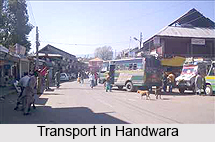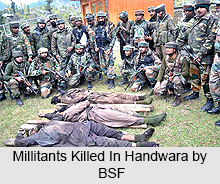 There is no dearth of cities and towns that have been built in every nook and corner of the state of India. In the state of Jammu and Kashmir also there are many towns that have been built over the years. In the Kupwara District, Handwara is a significant town, which is under the control of a `notified area committee`. In other words, Handwara is one of the tehsils of the Kupwara district. Handwara is one of the relatively unknown areas of Kashmir with vast tourism potential is the valley of Bungus. The valley, which lies at an altitude of around 10,000 ft above sea level, lies in the northern border district of Kupwara within the Handwara sub district.
There is no dearth of cities and towns that have been built in every nook and corner of the state of India. In the state of Jammu and Kashmir also there are many towns that have been built over the years. In the Kupwara District, Handwara is a significant town, which is under the control of a `notified area committee`. In other words, Handwara is one of the tehsils of the Kupwara district. Handwara is one of the relatively unknown areas of Kashmir with vast tourism potential is the valley of Bungus. The valley, which lies at an altitude of around 10,000 ft above sea level, lies in the northern border district of Kupwara within the Handwara sub district.
Location of Handwara
It is a Municipal Committee city in district of Kupwara, Jammu and Kashmir. The Handwara city is divided into 13 wards for which elections are held every 5 years.
Demography of Handwara
The Handwara Municipal Committee has population of 13,600 of which 7,379 are males while 6,221 are females as per the report of census in 2011. It has its own Tehsil office, ADC office, District Hospital and a police station. What is interesting is that the average literacy rate of Handwara city is less than that of the national average which is measured to be 59.5%.
Geography of Handwara
Handwara is located at 34.40 degree N 74.28 degree E. It has an average elevation of 1,582 metres (5,190 feet) above sea level.
Infrastructure of Handwara
Handwara is connected to the rest of Jammu and Kashmir with macadamized roads. A bypass has been constructed overseeing Handwara town to relieve the main roads of growing traffic. It is connected to Baramulla district via Baramulla-Handwara Highway passing through Watergam town.
Education at Handwara
Handwara is a town with great dignitaries and educationalists. As per Census 2011, literacy rate of Handwara city is 77.26%, higher than state average of 67.16%. In Handwara, male literacy is around 87.40%, while female literacy rate is 64.91%.
 Historic Events at Handwara
Historic Events at Handwara
The killing of 26 civilian protestors on 25th January 1990 at downtown Handwara, Jammu and Kashmir by the border security forces is considered to be one of the cold blooded killings. This is known as Handwara massacre.
Places of Interest at Handwara
There are certain places of interest in Handwara, which have drawn the attention of people from every part of the country. Wrecks of Ramkund temple at Farkaian; Nandrishi Pir`s Tomb at Magam; Shardania temple at Guglusa; Dhyaneshwar temple at Smattan are quite significant.
Due to its integrity with the Kupwara district, it is obvious that the Handwara too is going to follow partly the tradition and trend of the district as a whole. Due to the deficiency of irrigational facilities, majority of the people of Handwara follow cultivation and farming. Walnuts are the major gardening products. There is a huge possibility for the growth of quite a number of small scale industries due to the prevalence of large forest areas. Nurturing of livestock is also a significant job of the people. There is no medium or huge scale industry in the district.



















